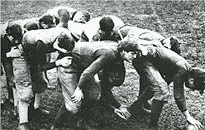
His coordination and footwork were so wonderful that he could take chances and do things that others wouldn’t dare to. He did everything with a kind of showmanship that wasn’t showmanship because it was natural to him. He was the only player on the field you looked at, the only player you saw. Never wore a headguard in football, and I remember that great shock of blond hair - Hobey standing waiting all alone. Everybody would just stand up when he got the puck or caught the punt. Tunis wrote: ”The whole atmosphere was electric when ((Hobey)) was playing. John Tunis, author of innumerable sports novels for boys, found the inspiration for his immaculate heroes in Hobey. Now and then he came down from Olympus to fraternize with the freshmen, and Fitzgerald actually spoke to him one day in October.” loomed so high in the heavens that he was scarcely visible. Fitzgerald describes Amory sitting on the steps of his Princeton rooming house as ”a white-clad phalanx” of singing students passes by: ”There at the head of the white platoon marched Allenby, the football captain, slim andĭefiant, as if aware that this year the hopes of the college rested on him, that his hundred-and- sixty pounds were expected to dodge to victory through the heavy blue and crimson lines.”įitzgerald biographer Andrew Turnbull wrote that in the Princeton of that time, ”varsity football players were looked upon as demi-gods, and ‘Hobey’ Baker. It is no accident that the protagonist of Fitzgerald’s first novel, This Side of Paradise, is named Amory Blaine or that Hobey should appear as a character named Allenby. Scott Fitzgerald, who entered Princeton in the fall of Hobey’s senior year, 1913-14, saw him as ”an ideal worthy of everything in my enthusiastic admiration, yet consummated and expressed in a human being who stood within ten feet of me,” according to Davies. Add to all this a humble manner, a noble character and what his biographer, John Davies, calls ”a foreboding, a sense that Hobey was somehow playing out a Greek tragedy,” and you have the stuff of literature.į. With wavy blond hairĪnd soft blue-gray eyes, he was among the handsomest of men, so disarming in appearance that his contemporaries at Princeton were not embarrassed And he was so flawlessly proportioned, so impossibly graceful in body and manner, that he seemed to tower over his fellows. and 160 pounds, but not so small at a time when the heaviest of football linemen weighed barely 200 pounds. He was, by our standards, a small man, only 5 ft. He was the beau ideal of American sport, a hero in every particular. Football statistics were considered declasse in Hobey’s time, but the 92 points he scored in 1912 was Princeton’s single- season record for the 20th century until 1974.īut Hobey was much more than the sum of his achievements. The Hobey Baker Award is collegiate hockey’s equivalent of the Heisman Trophy. He is a charter member of the latter, and he was the first American-born player inducted. Hobey is the only athlete elected to both the College Football Hall of Fame and the Hockey Hall of Fame.

That he should now lie ignored in the city of his birth is the final irony in the amazing saga of Hobart Amory Hare (Hobey) Baker, in his day and perhaps forever the most romantic figure in all of sport, an athlete who surpassed even his most daring feats with the sheer magic of his person. I THINK SOME DAY YOU MAY HAVE FLOWN TOO HIGH, SO THAT IMMORTALS SAW YOU AND WERE GLAD, WATCHING THE BEAUTY OF YOUR SPIRITS FLAME, UNTIL THEY LOVED AND CALLED YOU, AND YOU CAME. WITH THAT SWIFT LOOK OF THOSE WHO KNOW THE SKY, IT WAS NO BLUNDERING FATE THAT STOOPED AND BADE YOU BREAK YOUR WINGS, AND FALL TO EARTH AND DIE, It is only the anonymous verse beneath the inscription that suggests the splendor of the man buried here:


HOBART AMORY HARE BAKER CAPTAIN 141ST AERO SQUADRON, AEF The inscription on his modest stone, shadowed now by the skeletal limbs of barren trees, reads: But in the winter wind, only dead leaves dance on Hobey’s grave. Palatial mausoleums command the hilltop, and even the lesser monuments below are ennobled with flags and wreaths and scattered flowers. The headstone is scarcely distinguishable from neighboring prominences on lot 12 in the Rockland section of the vast West Laurel Hill Cemetery in the Philadelphia suburb of Bala Cynwyd.


 0 kommentar(er)
0 kommentar(er)
